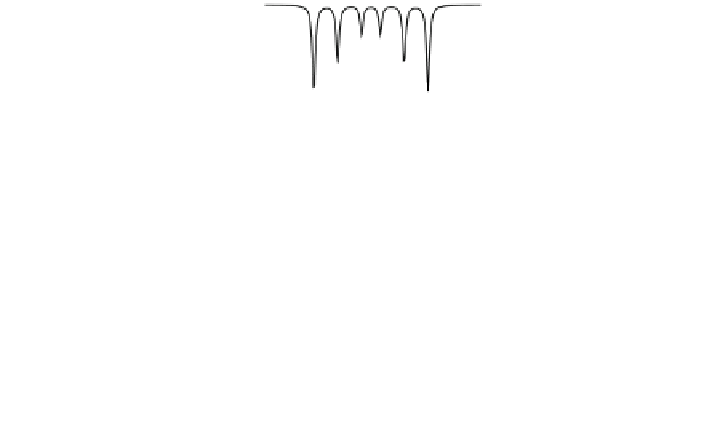Chemistry Reference
In-Depth Information
Fig. 4.3 Theoretical
Mössbauer spectra on linear
and non collinear magnetic
structures in presence of
external field applied parallel
to c-beam: random powder in
zero-field, ferromagnetic with
magnetic moments anti-
parallel and parallel to the
magnetic moment, and
antiferromagnetic structures
and non collinear magnetic
structures (see text)
B
app
//
γ
-beam
Random
F (B
hf
< 0 )
SP
F(B
hf
> 0)
SPi
ASp
AF
-10
-5
0
5
10
-10
-5
0
5
10
V [mm/s]
V [mm/s]
broadening occurs when the local atomic probe environment is disturbed by static
effects, i.e. chemical or topological disorder or in presence of electron or magnetic
dynamics. In the case of magnetic nanostructures, the magnetization is not sys-
tematically static and both its orientation and magnitude may fluctuate. When the Fe
moment is submitted to relaxation effects, the hyperfine structure of the Mössbauer
spectrum is dramatically modified, particularly its line shape which has widely
discussed in the literature. Several theoretical descriptions have been proposed,
assuming that the values of +B
hf
and -B
hf
and that the relaxation is a stochastic
process with an average relaxation time. The calculations become quite complex and
some approximation can be done when the superparamagnetic particle exhibits
uniaxial symmetry when KV
k
B
T. Figure
4.4
illustrates theoretical
57
Fe
Mössbauer relaxation spectra using longitudinal relaxation with different relaxation
times assuming B
hf
=±55 T and an axial electric-field gradient parallel to B
hf
.
Three regimes can be distinguished by comparing to the characteristic time of the
Mössbauer measurement (5.10
-8
s) which results from the nuclear Larmor preces-
sion time in the magnetic hyperfine field. Large (s C 5.10
-8
s) and short
(s B 10
-10
s) relaxation times give rise to broadened lines sextet and quadrupolar
doublet (or singlet), respectively, while spectra with very broad lines with a gradual
transition from a sextet to a doublet are expected for intermediate range of relaxation
times. But it is clear that the physical modelling of the hyperfine structure becomes
dramatically complex when the sample consists of an assembly of polydisperse non
interacting magnetic nanoparticles because the distribution of time relaxation has to
be considered!
Consequently, the interest of Mössbauer spectrometry applied to nanomaterials
can be large and relevant in terms of both structural and magnetic characterization.
Nevertheless, great attention has to be paid to the modelling of hyperfine structure






























































